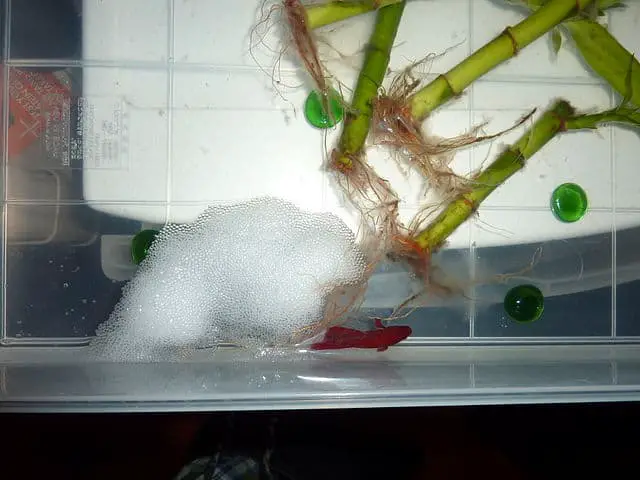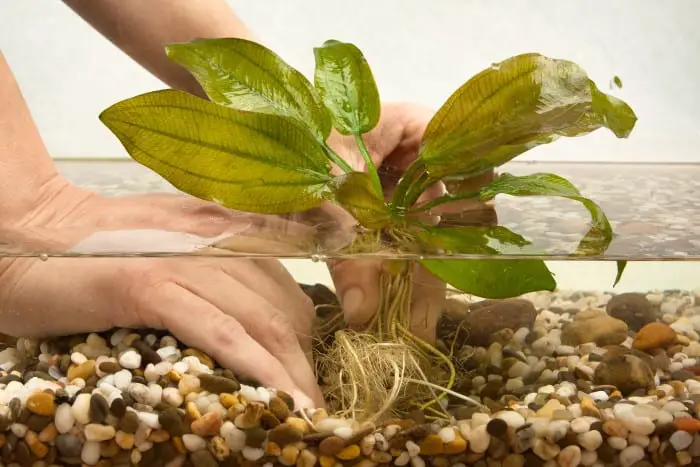There are a lot of reasons betta fish are an interesting fish to keep. For one, they are showy and have great personalities. But they also have some very interesting behaviors and one of those behaviors is building bubble nests.
You may have heard about them or seen them in your own betta tank. They look almost like spit or foam floating on the water. The way bettas construct and use these to raise young is very interesting. So please, read on to learn more!
What Is a Bubble Nest?

Betta fish are bubble breeders. This means that they build a nest of bubbles as a shelter for fertilized eggs and young betta fry. These bubbles are air bubbles coated with the bettas saliva. This saliva gives the bubbles durability so that they last long enough for the fertilized eggs to mature.
Fish that build and guard these types of nests are known as aphrophils. Aphrophils also include other fish like gouramis as well as some frogs and eels.
With bettas, these bubble nests can vary in size drastically. Sometimes there will only be a couple dozen bubbles. Other times there will be hundreds forming a 1-inch thick mat taking up the entire corner of a tank.
How Do Betta Make Bubble Nests?
As soon as male betta fish are mature enough to reproduce they will have the desire to build bubble nests. I should mention that while this is a predominantly male behavior, female betta fish will sometimes attempt to blow bubble nests as well.
This is an ingrained behavior and female produced bubble nests never get used for breeding.
The frequency of this behavior will vary. Sometimes they will build nests weekly and sometimes monthly. It really depends upon a variety of factors which include genetics, age, and habitat.
When a male betta fish is ready to start building his bubble nest he will look for a suitable location. This will, of course, be at the surface of the water but there are some other requirements as well. A bubble nest is inherently fragile and needs some help from its surroundings to be a good home for the young.
Calm water is the first need. Even though the bubbles are coated with sticky saliva any water current can pull apart a new nest. So the betta will keep the nest as far away from these areas as possible.
This is also why they will also attach the nest to some type of plant or other feature near the surface of the water. This gives the sticky bubbles something to adhere to. It also provides additional protection and cover for the eggs.
Bubble Nests And Breeding
Once the bubble nest is constructed mating may begin if a female betta is present. This mating ritual involves the male betta wrapping himself around the female. The female releases small numbers of eggs at a time that are fertilized by the male.
As these eggs are released the male will catch them with his mouth and deposit them in the safety of the bubble nest. Once all of the female’s eggs are released the male will drive her away. This is because the female betta may actually attempt to eat any loose eggs.
The male betta will guard the nest until the eggs hatch and the fry are old enough to leave its protection.
Why Isn’t Your Betta Building a Bubble Nest?
While this is a very common behavior for male betta fish it doesn’t always happen with some betta. You may have a betta fish that hasn’t blown a bubble nest at all. Betta fish are not all the same and some may have a stronger urge to blow bubbles than others. This does not mean there is something wrong with your betta fish.
It is possible that your betta has built his nest underneath plant leaves or other objects in your tank. So make sure you do a thorough search before you assume your betta is unhappy or just lazy.
There may also be some environmental factors that are preventing this behavior. These are highlighted below.
Ways To Promote Nest Building
These are some factors you can address to promote betta nest building.
- Keep the tank clean
- Ensure water temperature is 76-82° F
- Minimize water flow
- Provide cover with plants and floating objects
- Introduce a female betta
Keep Your Tank Clean
First and foremost, cover the basics that you would for any fish or aquarium. Make sure you do regular water changes and clean your tank. When you clean your tank look for any signs of bubble nesting.
Monitor your pH and ammonia levels so you know when issues with water quality arise. A betta fish in dirty water may not be in the mood to nest.
Ensure Water Temperature is Correct
You also need to make sure that your water temperature is warm enough. Most small betta bowls have no heater and the water is too cold (do betta fish need a heater).
Because fish are cold-blooded cold water leads to an inactive betta. So make sure you keep your water temperature between 76-82° F.
Minimize Water Flow
Another important factor is water current. Your betta may be trying to construct a bubble nest but there might be too much water flow to get one established. This can be mitigated by buying a filter with adjustable flow as well as installing a DIY water baffle.
How do you know if there is too much current? Watch your betta swim around the tank. Is he swimming freely or does it look like he’s getting pushed around? When you feed him does the food slowly sink in one spot? Or does it move around in the water?
You can also reduce the water current by providing cover and structure as explained below.
Provide Cover And Structure

Remember when I said that bettas like to attach their bubble nests to objects? This can be used to your advantage. In nature, wild bettas have all kinds of structures to attach and hide their bubble nests in. This includes live and dead plants, woody debris and so on.
If you don’t have any plants already add some that reach the surface of your water. I prefer a live planted betta tank for this and other reasons.
Along the same lines, you can add floating objects that the betta may choose to build under. These include floating aquarium plants as well as other objects like a styrofoam cup cut lengthwise.
Add A Female Betta
Adding a female betta can be a strong motivation for a male betta to start building a bubble nest. Knowing a female betta is nearby will likely kick his mating instinct into high gear. I wouldn’t add one to the same tank though unless you know what you are doing and are serious about breeding. A better way would be to add a divider to the tank or set two tanks together.
This may work by adding males nearby as well but this can stress your bettas out. It will spark an aggressive territorial instinct in your betta. There’s a reason they are traditionally known as siamese fighting fish. If you want to do this only do it for short periods of time.
Final Thoughts
Bubble nesting is just one of the things that make betta fish keeping such an exciting hobby. While they are not necessary unless you want to breed it is interesting to watch and see. It’s just one sign that you have a happy, healthy betta.
So if it’s something you want to promote with your betta try some of my suggestions. On the other hand, it is totally fine if you want to remove them when you clean your tank. Your betta will simply build another one when he chooses.
Hopefully, this has given you a little more insight into this amazing little fish!

